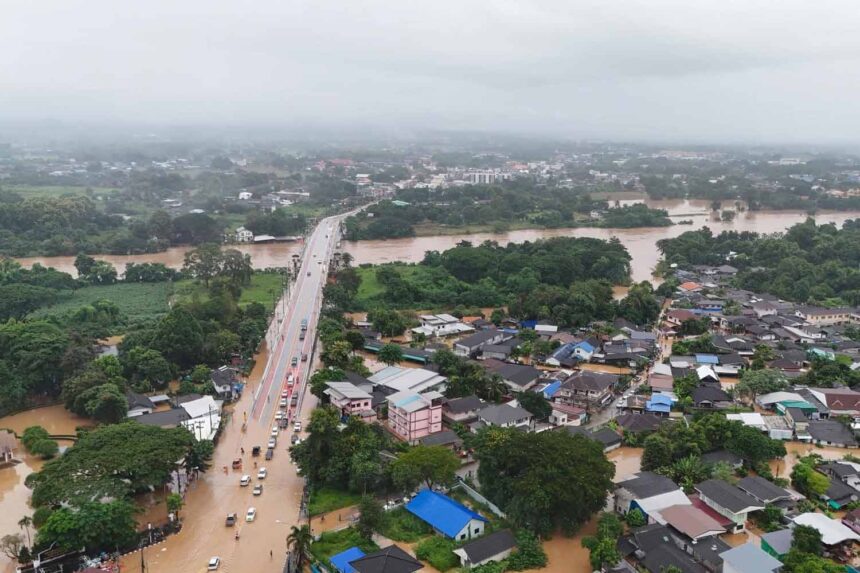Reflecting on the severe flooding in Chiang Rai in 2024, Assoc. Prof. Dr. Satien Chanta, an expert in natural resource and environmental management from Chiang Rai Rajabhat University and a member of the Northern Mekong Basin Committee, recently warned that the province lacked practice of and flood prevention plans.
Dr. Satien Chanta said that while flood prevention plans exist, they have never been properly rehearsed or executed. He warned that although the National Water Resources Office (NWRO) has shared plans, there has been no follow-up to ensure these measures are carried out effectively or that the public is informed.
“The issue is that only government officials are aware of these plans. When a disaster occurs, confusion sets in, and the damage ultimately affects the people,” Dr. Satien explained.
Pollution Challenges and Environmental Concerns
Dr. Satien also addressed pollution of the Mae Kok River from gold mines in Shan State, noting that the key to resolving environmental pollution lies in tackling the source. He emphasized that effective action must start at the origin of the issue, with secondary efforts focusing on containment.
For example, while chemicals can be managed in closed systems, large ecosystems like rivers, such as the Kok River, pose significant challenges. With a basin size of 7,300 square kilometres, tracking and managing contamination is incredibly complex.
“I’ve reviewed global studies and found that pollutants, including heavy metals, can deeply impact ecosystems. Fish, birds, aquatic life, and even crops absorb these toxins, leading to severe food chain disruptions. Over time, this can devastate communities relying on these resources,” Dr. Satien stated.
He added that addressing the impact on those exposed to pollutants, including farmers, fishermen, and those in the recreation and tourism sectors, is equally critical. Dr. Satien also raised concerns about the inability of water utility providers to build public trust through better transparency.
“People need to trust that raw water meets quality standards before it’s treated. Heavy metals, for instance, require specific processes that current systems struggle to manage effectively. Random water quality tests at multiple points, from treatment facilities to distribution outlets, must meet World Health Organization (WHO) standards. The results should be made public to reassure the community,” he said.
Lack of Urgent Action in Chiang Rai
Dr. Satien expressed uncertainty about whether a centralized response team has been established in Chiang Rai to address these issues. He stressed the need for clear communication channels so affected residents can report problems and receive updates. Local health offices and municipal bodies should implement proactive measures to monitor and address health and environmental risks.
“There’s an urgent need to treat this as a national priority. Transboundary pollution issues, particularly from neighbouring Myanmar, require political solutions. With foreign investments from China, Russia, and Thailand in Shan State mines, addressing these environmental risks is critical. Communities in the Kok River basin should petition the Prime Minister and ministers to take immediate diplomatic action,” he urged.
Dr. Satien pointed out that solving these issues at the source is far more effective than dealing with the aftermath. He called on the government to pressure mining operations to mitigate their impact or cease operations altogether.
Seasonal Flood Response Plans Unrehearsed
As the rainy season approaches, there appears to be little preparation for potential flooding. Dr. Satien revealed that while the government has outlined nine flood response measures, no drills or public information campaigns have been conducted.
When asked about the rising turbidity levels in the Kok River, which have increased eight to nine times, he explained how it impacts the ecosystem. “High turbidity reduces sunlight penetration and oxygen levels in the water, disrupting aquatic life. Treating such water for consumption requires significantly more aluminium sulphate to settle the particles, increasing costs and challenges.”
Dr. Satien also raised concerns that these issues might extend to the Mekong River, as the Kok, Sai, and Ruak Rivers—often exceeding heavy metal standards—flow into it. He urged authorities to carefully assess the Mekong’s quality before shifting water sources for public use.
Impact on Tourism and Local Vendors
During the Songkran holiday, when locals and tourists typically enjoy riverside activities, the beaches along the Kok River, such as Chiang Rai Beach and Yonok Beach, were unusually quiet. Fears over arsenic contamination in the water discouraged visitors.
Kanya Wangjongklang, a vendor at Yonok Beach, shared her struggles. “This is my first year renting space to sell goods. I invested nearly 100,000 baht, expecting strong sales during the festival. But after just three days, news about arsenic contamination kept tourists away. Now, I’m not sure if I’ll even break even,” she said.
Arsenic Warnings Issued in Mae Sai
In Mae Sai district, high arsenic levels of 0.014 micrograms per litre were found in the Sai River, surpassing safety standards. Local authorities advised residents to avoid using water from the Sai River and irrigation canals, even for Songkran celebrations, until further safety confirmations are issued.

Anna Wong serves as the editor of the Chiang Rai Times, bringing precision and clarity to the publication. Her leadership ensures that the news reaches readers with accuracy and insight. With a keen eye for detail,














